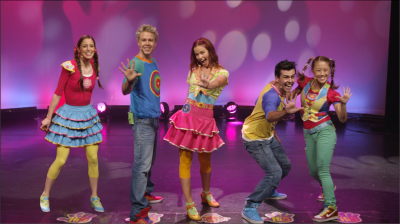
(Julie Greene)
Q: Can you provide an update on the latest season of Hi-5?
A: The new series of Hi-5 is series 14th. We’re renaming it to Hi-5 House, so it will be Hi-5 House series 1. The idea behind this is that the house where the cast all live in together becomes an environment. If there are cast changes from different places and different territories, they will all live in this place called the Hi-5 House. I thought initially that the set in the studio and the space where the cast performed were quite ambient. You didn’t really have a tangible sense as to where they were in space and time. It might be nice to give them some context – like a group of friends living together under one space and having some fun, close-by and all under one roof.
The set is designed like a hand and each of the cast member lives in the little pod which represents the fingers of the hand. Each pod reflects what they do – music, or shapes.
When the children come to watch the show, they are actually going to be stepping into the Hi-5 House, joining in the fun and energy of the show with the new cast. It’s a little bit more inclusive.
Q: What about the segments within the show?
A: The segments within the show remain the same. It will still have “Shapes and Space”, “Puzzles and Patterns”, “Word Play”, “Body, Move, Music” and of course, the ensemble segment of sharing stories. They all still exist but we’re adding in a new segment to the line-up and it’s called The Chatterbox. It’s actually the world inside Chats’ box. It’s all puppets. Chats is in the word-play segment and she’s a little puppet. Inside her world, we will also have a new human character that will be dressed in a costume. She’s called Tinka, a tiny toy robot.
The Chatterbox is an English-learning language segment. Tinka doesn’t speak. She talks in beeps and bops and Chats teaches her how to speak. It should be really cute.
Q: We know you had to re-cast. How did we get to this point?
A: I think the original second cast had always been signed for duration of three years and then, it’s extended further for a year. Being quite a young cast, I think that the three that moved on had aspirations to do other things in the entertainment industry. Tim Maddren who did the music segment is now in the musical stage show The Addams’ Family. Casey Burgess wants to sing and have a pop-singing career. Fely Irvine went on to New York and is studying acting.
The transition was all good and by choice. Hi-5 has sort of become a club with many members so they all still support one another.
(The cast of Hi-5 Season 14, from left: Ainsley Melham, Dayen Zheng, Lauren Brant, Mary Lascaris and Stevie Nicholson. Following the departures of Fely Irvine, Tim Maddren and Casey Burgess; Melham, Zheng and Lascaris, who have been selected from a worldwide hunt that was documented in a feature film; will make their television debuts in season 14, which will be renamed Hi-5 House Season 1.)
Q: How would you ascertain during auditions if the new cast would work prior to production?
A: During the audition process, we actually had the auditionees singing and dancing with Lauren (Brant) and Stevie (Nicholson), so we could see what the dynamic was in each combination. That was difficult because you’re casting in context with the rest of the group. You’re (also) looking at the group having diversity, different personalities and looks.
Q: Was there an “acid test” on how the children would respond to a particular cast member before you showcased him/ her?
A: It was really important to find out that if they had a rapport with the children. For example, Mary (Lascaris) who was cast did children’s birthday parties. She has also worked with Disney Japan and was thinking about doing a teaching degree. She was quite passionate about children. We definitely had to talk to them about their own childhood to see if they still had that sense of play – very important in performing.
Q: Hi-5 the production will now transition to Singapore. Where are we now in terms of this move?
A: That was one of the reason why I came over is to look at the studios and meet with the people from a soundstage we’ve identified, and Oak Three Films, who are potentially our partners in Hi-5. They also lined up a number of key crew members for me to meet. That was really interesting when you’re looking at a show like Hi-5. The energy on the studio floor has to be really buoyant and fun. I‘ve seen the sound stages I’m been introduced to and they’re amazing. It’s a massive space. We will be the first production to go into that studio.
Q: What were you looking for, technical-wise?
A: What’s great about this soundstage is that they can have everything contained within one area because we’re delivering quite often while we’re still shooting. We need to turn things around quite quickly. Having the post-production facility, the visual effects, an editor, and production offices on-site at the studio is really important.
The other thing is that Hi-5 is quite theatrical with the props and costumes. We build those on-set. We needed space in the workshop to accommodate them. Also, we’ve got two floors of production offices with editing suites. The studio floor itself is so big; we can accommodate the audiences of 50 children in the studio now.
Q: The cast will be flown down? What about the children? What about other creative components like composers and so on?
A: Yes, we’ll be getting the children here (in Singapore).
Our Australian composer, Chris Harriott, has been on the show since series 1. He does every single piece of composition that happens on Hi-5. He has produced thousands of small songs and he just does it all by ear. He’s really a cornerstone of Hi-5 but he will be based in Australia, doing all of the compositions of the main songs before we come over.
In terms of key creative staff, we’ll be bringing the director, art director, lighting director and probably a first-assistant director to do all of the scheduling. Also, myself! Hair and make-up will probably come out in a week or so to try out the local people for doing the looks on Hi-5, and also, costumes. We’re looking to hand over a lot of the skills to local people.
Q: How long do you figure that you would be here for?
A: For this first series of Hi-5 House, we’re looking at shooting for ten weeks. Post-production will probably go for another 10 – 12 weeks. Personally, I’ll be here for six months.
The key crew will mainly be there for the shoot period and maybe a week or two prior. We are looking at about three months. The cast spend a lot of time in Asia now, and after the series, they will probably do a little bit of touring within the region.
Q: How are you involved with the tour?
A: I write the stage shows. In Australia, we’re currently writing a series and there’s a team of six writers who are doing that. After I’ve digested all of the content, I’ll try to adapt something new for stage. We’re really excited about the new stage show. We want to make it a bit bigger because I had written a smaller style show for the old cast of Hi-5 and it’s for smaller venues around Australia. They then brought it to Singapore and held it at Marina Bay Sands. I came over, and I’ve never seen any of my shows overseas go out. It was so big and it was pretty amazing to see.
Singapore is a home away from home for Hi-5. The fans in Singapore are very special to the cast, particularly. For them to be performing what’s meant to be a small show in an amazing venue with thousands of children in that environment was so amazing.
Q: Which tours are currently confirmed?
A: Indonesia’s coming up and it’s our first time. It will be a small show. The set for Jakarta looks amazing. This will be before they shoot the series. It will be great for us to the test the market because we have format licensing interests in Indonesia. We are inviting broadcasters to come for the show so that they get an idea of it, meet the cast etc.
Q: You have a new concept , a new cast and a new location. What are the challenges you expect in this new venture?
A: Well, I don’t expect it to be clockwork, like the well-oiled machine that was running in the same studio for the last three years with the same people doing it. To have an expectation that is going to be replicated exactly like that over here, I don’t think so. The positive thing is that we’ll have a lot of fresh eyes so that’s going to give the show a fresh new influences, and that is exactly what it needs to evolve because the brand has been going since 1999. You need those new contributors.
The way I’m trying to approach is that with all this freshness coming in, it’s going to give the show a new energy. My job is to make sure that the energy is really positive and that everybody who comes on the show has that Hi-5 experience. We want to create that spirit of play in the studio with everybody. There are variables and the cast is new. For the three new (cast members), this will be the first time they have ever performed for television. I think there will be challenges there to have them relaxed and playful.
Q: So far, we see that the children are confined to a floor space. Would they mingle more now?
A: No. In terms of production with the audiences, we shoot all of the stuff with children and the songs at the beginning. After that, it’s a closed set with no children. We shoot quite a lot in a day – about six episodes a day.
The reason why there has to be a playful energy on the floor is because performers have to perform as if the children are there without being so self-conscious, especially for the boys (male cast of Hi-5). They have to dress up as merman and ridiculous characters and still be okay without being self-conscious. It takes a certain kind of person.
For example, we were interviewing the cameraman and just meeting some of them. I was saying how it is really important that our main cameraman, who does close-ups on their faces, is a smiley, affirming person. The cameraman has to be there and enjoying it so that the cast is getting that energy back. I don’t want someone who’s on their mobile phone, just looking up now and then, on the team.
Q: Can you comment on the relationship with Network Nine which has come to an end?
A: I’ve worked with Channel 9 for many years. They were always one of the joint venture partners on the show. In Australia, several companies like Network Nine and Southern Star have been bought over by various international companies – like Southern Star was bought over by Endemol. Channel 9, at the time, was owned by a venture capitalist, whereas before it was with Kerry Packer, who had a personal interest in the shows. There was a lot of pride in local productions and when it opened up to anonymous venture capitalists owning it or a huge production company for whom Australia is very far away, we were a big cost to them.
Nine, in particular, went through a lot of trouble and we were an asset that they could sell off at the time. There was a buyer and he was happy to have us and saw a lot of growth because we’re launching a new cast and redeveloping the show. If you’re with a network that’s struggling, and can’t put in the money to tour and market the brand, you’re in a bit of trouble.
The good thing was Ron Tan, one of the directors of the company, had been involved with Hi-5 for many years from way back when the original owner had it. He used to look after the touring and merchandise in Singapore. He knew that the fan base here was solid and that the brand is strong. It just needed this new energy and finance to sort of lift it to a new level.
It would be nice for Channel 9 to see us really succeed very well. I just don’t think they had the capability at the time to spend money on children’s television. That was kind of the first thing to go, really, and they had a buyer for it. It wasn’t really a matter of closing the show down and saying goodbye. They can actually sell the brand.
Q: With the change in ownership, what are the possibilities now?
A: I think because a company like Asiasons is owning the brand, they have so many diverse business interests and do business in so many areas of emerging Asia that one thing we’ll probably see is the branding franchised out. So, there will be local casts particular to the countries performing Hi-5.
In Latin America, we’ve got a huge fan base but we’ve never really toured there. We’ve never franchised there but it’s potentially something we could do – in Vietnam, Korea, and Taiwan – markets where Asiasons does business. It can open doors for us to produce a licensed show of Hi-5. I think that will be a new thing. Rather than just one cast, there will be several.
Q: Is MDA involved in supporting your productions here in Singapore?
A: Yes, potentially. We have met them a couple of times. They’re excited and we do definitely see them getting involved in the future. Financial support for the moment. We haven’t discussed anything but we understand that any production in Singapore can get a 40% funding. We are planning to tap into that. We are committed to meeting the requirements.
But it’s great as the show has never been funded by a government body in Australia before. To have that support here in Singapore is amazing, really. I think it’s a really big incentive for any production to come to Singapore, because it is supported.











